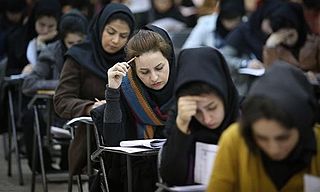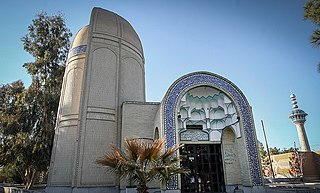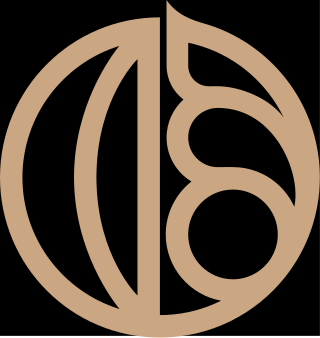
The Shiraz Metro is the rapid transit system in Shiraz, Fars, Iran, operated by Shiraz Urban Railway Organization. Construction began in 2001, and service in the first line officially commenced on 11 October 2014.

The Iranian University Entrance Exam, simply known as Konkour, is a standardized test used as one of the means to gain admission to higher education in Iran. Generally, to get a Ph.D. in non-medical majors, there are three exams, all of them called Konkour.

The Ahmad al-Badawi Mosque, is a mosque and shrine complex in Tanta, Egypt. The name of this mosque is derived from the Sufi mystic Ahmad al-Badawi, the founder of the Badawiyya Sufi order, who is buried in the shrine of the building. The mosque is also the largest and most-visited mosque in Tanta.

The Islamic Azad University, Isfahan (Khorasgan) Branch is a university located in the eastern part of Isfahan. It is part of the Islamic Azad University, an Iranian university system. It was established in 1987. The university has more than 19,100 students at undergraduate and postgraduate levels. It has 386 full and part-time faculty members who teach and perform research in 196 fields, and they more than 75,000 alumni.

Roknolmolk Mosque formerly known as the Aksa Mosque is a historical mosque in Isfahan. This mosque was built in Qajar era and is next to Takht-e Foulad cemetery. It was named after and founded in 1901 by Mirza Soleyman Khan Shirazi, who is known as Roknolmolk.
Fenart is an incorporated village in District 4, Isfahan city Jey Rural District, in the Central District of Isfahan County, Isfahan Province, Iran. At the 2006 census, its population was 2,023, in 503 families.

Takht-e Foulad, also known as Lissanul Arz is a historical cemetery in Isfahan, Iran. It is a large funerary complex that includes several historic mausoleums, mosques, tekyehs, sub-cemeteries and standalone graves.
Gardan Kolah is a village in Mashayekh Rural District, Doshman Ziari District, Mamasani County, Fars Province, Iran. At the 2016 census, its population was 16, in 5 families.

Saman Nariman Jahan is an Iranian professional football player who plays as a winger for Naft Masjed Soleyman in the Persian Gulf pro league.
Mohammad Pour Rahmatollah is an Iranian football midfielder who plays for Malavan in the Azadegan League.

The Border Guard Command, commonly known as FARAJA Border Guard, is a subdivision of the Law Enforcement Force (FARAJA) and Iran's sole agency that performs border guard and border control duties for land borders, and coast guard duties for maritime borders. The unit was founded in 2000. Between 1991 and 2000, border control was the responsibility of the Security deputy of FARAJA. Prior to 1991, border control was the responsibility of the Gendarmerie.

The following is a timeline of the history of the city of Isfahan, Iran.

The Municipality of Isfahan is responsible for the management of the city of Isfahan, Isfahan Province, Iran. The highest-ranking official of this organization is the mayor of Isfahan, who is chosen by the Islamic City Council of Isfahan. The city of Isfahan has 15 administrative divisions and each division has its own mayor, who work under the mayor of Isfahan. The present mayor of Isfahan is Ali Ghasemzadeh.

The Islamic City Council of Isfahan is the directly elected council that presides over the city of Isfahan and elects the Mayor of Isfahan in a mayor–council government system.

Iran has international borders with 13 sovereign countries, both on land and sea. It has a total of 5,894 km land borders with Iraq, Turkey, Azerbaijan, Armenia, Turkmenistan, Afghanistan, and Pakistan. With a total of 2,440 km coastline, it has maritime borders with 6 other countries: Kuwait, Saudi Arabia, Bahrain, Qatar, the United Arab Emirates, and Oman. Iranian Turkey border has dug 376 kilometers moat along border, there is a four meters height concrete wall.
The Mausoleum of Shah Rokneddin is a historical mausoleum in the Shah Rokn-ed-din district of Dezful, Iran. It was built during the Timurid period, and it is number 8386 on Iran's list of national monuments. The mausoleum entombs the remains of a son of Baba Rokneddin Wali.
The Book and Documentary Heritage Museum of Iran, an artistic historical museum based on the display of paper works, is one of the sections of the National Library and Archives of Iran. In this museum, a selection of historical works including books and non-books materials, documents, manuscripts, calligraphic tableaux and painting, periodicals, rare and exquisite printed books and works related to celebrities are exhibited.

Conjugal Visit is a 2022 Iranian romantic drama film directed by Omid Shams and written by Omid Shams, Bahman Ark and Ali Sarahang. It stars Parinaz Izadyar and Hootan Shakiba as Parvaneh and Farhad, a couple who met secretly through Farhad's phone in prison which he sometimes borrow it to Parvaneh's father—who is in prison with Farhad—to call his daughter, and started to develop feelings for each other.
Risbaf was a textile spinning factory built in 1932 in Iranian city of Isfahan by German architects Max Oto Shonman and Iranian master builders called "Ostadmemars".















